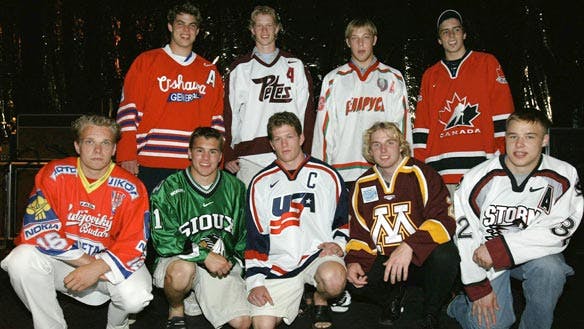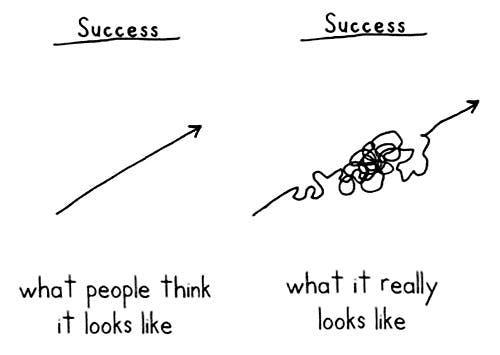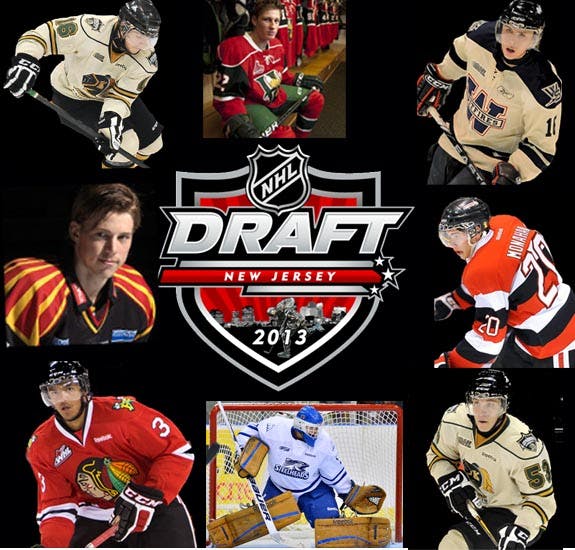Identifying The Deep Draft
By RexLibris
11 years ago
2013 is supposedly a deep draft year, something rivaling the vaunted 2003 draft class according to many observers. By all accounts this is the year to sell the farm for as many first round picks as you can get and then just sit back and draft five or six future NHL stars and stalwarts.
But is it, really? And even if it is a deep draft year, what exactly does that mean?
I love the draft, and have already spent considerable time poring over some advanced scouting reports and player descriptions trying to tease out some names to watch – I’m an Oilers fan, so I suppose there isn’t much else to do this time of year. For anyone who does this on their own time, as I do, one thing becomes abundantly clear – scouting is not an easy job and those who can do it, and do it well, deserve much more credit than they ever seem to get.
That aside, one thing that we can do from the comfort of our own computers is access that crystal-clear panorama that is hindsight.
I decided to go back and take a look at the 2003 draft class and compare it to the three draft years immediately preceding and following – 2000 through to 2006.
Prior to the 2005 CBA, there were nine rounds in the draft (basically they just kept calling names until somebody said “Tsujimoto”). The new CBA set the maximum at seven rounds. As such, there is a slight discrepancy in the sample sizes before and after 2005 (a drop of approximately 60 names called), which I feel is mitigated by the extremely small number of NHL players that emerged from that far down in the draft. The overall percentages remain well within the historical average.
Also, while there has been an increase in the number of undrafted college or European free agents since implementing the seven-round model, something that may or may not be attributable to this move, it is a very small group and to date these players have not had any more appreciable an impact on the game than in previous years.
To outline my methods, I looked at the total number of selections made and counted the number of players who had played 200+ games in the NHL (or in the case of the more recent drafts, were in line to imminently do so). This provides a percentage of the players selected who became regular NHL players for the equivalent of three seasons, give or take injuries, etc. Then, extracted from that list are the players who had gone on to become what is loosely (and, with apologies, somewhat unmathematically) described as a difference-maker in the league. For example, Patrik Stefan was drafted 1st overall in 1999, the same year that Ryan Miller was selected 138th (5th round) by Buffalo. Stefan would play 455 games, but would not be listed as a difference-maker while Miller, with 481 games, would. Simply put, Miller is a very good player at his position, Stefan was not. These players will be termed impact, elite or core, players at various times in this article.
Looking Back

In 2000 there were 293 draft selections made. Of those players, 46 went on to have NHL careers of more than 200 games, giving us an approximate rate of 15.6%. There were nine players in that draft class who stand out to me as being the elite players of their draft class: Dany Heatley, Niklas Kronwall, Ilya Bryzgalov, Lubomir Vishnovsky, Henrik Lundqvist, Scott Hartnell, Marion Gaborik, John-Michael Liles and Brad Boyes.
In 2001, there were 289 players selected. Of that group, 62 managed to play 200+ games in the NHL, for a rate of 21.4%, a good success ratio by most standards. This draft also produced a high number of core NHL players, twelve in all. This list includes Ilya Kovalchuk, Jason Spezza, Mikko Koivu, Ales Hemsky, Derek Roy, Fedor Tyutin, Michael Cammalleri, Tomas Plekanec, Patrick Sharp, Kevin Bieksa, Ryan Clowe, and Jussi Jokinen.
2002 saw 291 players selected, 45 of whom made the NHL cutoff line of 200+ games, approximately 15.4%. Of those, I counted 9 that would qualify as excllent-to-elite from their class, including Rick Nash, Jay Bouwmeester, Alex Semin, Kari Lehtonen, Cam Ward, Duncan Keith, Jiri Hudler, and Valterri Filpulla.
I’ll come back to 2003 at the end, but for now we’ll skip over that year and straight to 2004 in order to continue to establish a baseline.
In 2004, the last draft year under the pre-lockout-CBA that included nine rounds, there were 291 players selected, 48 of whom managed to reach my cutoff line for games played. The impact players in this group are Alex Ovechkin, Evgeni Malkin, Andrew Ladd, Travis Zajac, David Krejci, David Booth, Johan Franzen, Alex Edler, Mikhail Grabovski, Pekka Rinne, and Mark Streit – eleven in total.
The following year the draft was reduced to seven rounds and only 230 names were called. 40 of those prospects make the cutoff for 17.4%. The list of core players from that draft class is as follows: Sidney Crosby, Bobby Ryan, Carey Price, Anze Kopitar, Marc Staal, James Neal, Paul Stastny, Kris Letang, Jonathan Quick, and Keith Yandle. Ten players stand out amongst that group, although to be fair, in this draft year and the one following, there are at most one or two more who may yet emerge.
The final year of our draft scope is 2006 wherein 213 players were selected, and from which 33 have thus far managed to get into 200+ games. Again, we are now six years removed from the draft so there may yet be one or two more who emerge from this draft class. Also, in this year’s class I have counted players whose game totals are below 200 but are set to surpass that milestone imminently. From that list, Jordan Staal, Jonathan Toews, Niklas Backstrom, Phil Kessel, Kyle Okposo, Claude Giroux, Brad Marchand and Milan Lucic make my list of impact players for a total of eight.
Now, to contrast with what we have discovered thus far, we go back to 2003. Of the 292 players were called, 67 have to-date managed at least 200+ games, or 22.9%. That is the highest rate of the years we will revisit, yet outstrips the 2001 draft class by only five players. Looking over the impact players from that class though is what sets this year aside: M.A. Fleury, Eric Staal, Nathan Horton, Thomas Vanek, Ryan Suter, Dion Phaneuf, Jeff Carter, Dustin Brown, Brent Seabrook, Zach Parise, Ryan Getzlaf, Brent Burns, Ryan Kesler, Mike Richards, Brian Boyle, and Corey Perry were all selected in the first round alone. Add to that group Loui Eriksson, Patrice Bergeron, Shea Weber, David Backes, Joe Pavelski, Tobias Enstrom, Dustin Byfuglien, and Jaroslav Halak, and you can see that this draft class had a wealth of high-end NHL talent to give – 25 in all.
It is important to note, though, that outside of the first round, the number of future NHL players selected in the later rounds reverted to the normal range produced per draft class. The depth of the draft is reflected primarily in the first round. The occurrence of a few outstanding individuals taken in the later rounds is common enough in countless previous draft years and cases like Nikolai Khabibulin, Pavel Datsyuk, Patrik Hornqvist and so on.
Obligatory Excel Table!

You can review everything here in this table for easier comparison.
I’ve highlighted in orange the close similarities that 2001 and 2003 have in their general player production to give an idea that it isn’t outside the norm for an occasional draft year to provide a bumper crop of prospects to the NHL. However, in the centre bottom in yellow is the number of high-end players that came out of the 2003 draft. That is where the strength of that draft class truly lies, not in providing the league with more Eric Nystroms and Zach Stortinis, but in that, with astonishing regularity, core players around which teams have been built were being selected all through the first round. The occasional hits on players like Shea Weber in the later rounds aren’t, as I mentioned earlier, outside the norm for any draft year, but when added to the phenomenal talent available in the first round alone, this draft class outshines all of its immediate contemporaries.
Take special note of the areas in green. These two cells indicate the number of impact (referred to in the table as core) players taken outside of the first round. 2001, a very good draft year by any standards, has a high number of impact players taken in rounds 2 through 9, while 2004, a middling-to-poor draft year, has a disproportionate number of its impact players selected after the first round. In fact, while only boasting fewer than half of the total number of high-end players from 2003, it almost equals the number of similar players taken with depth picks.
Real versus Perceived Depth

So, given all of this, what can we deduce about the likelihood of this year’s draft class based on early comparisons about its depth? Well, for starters, let’s just forget about expecting another windfall of NHL talent like we saw in 2003. That draft year is often compared to the 1979, 1980 and 1981 drafts that saw players like Dale Hawerchuk, Mark Messier, Kevin Lowe, Al MacInnis, Grant Fuhr, Andy Moog, and a host of other Hall of Fame players taken all over the draft board. The two are worlds apart when it comes to how teams and scouts evaluate talent and collect data.
We are exactly ten years removed from the 2003 draft class and it is too soon in the evaluation process to compare that class to this. Also, we would be guilty of historical revisionism to suppose that even the boldest of forecasters predicted this much success from that one year’s (2003) worth of prospects.
The 2003 draft saw exceptional talent all through the first round (with a few glaring exceptions) but then quickly reverted to the norm in that players taken outside the first round were approximately as likely to become NHL players, and even occasionally high-end players, as in any other draft year. Without 2003, there are on average five impact players who are selected each year outside of the 1st round. Even once the draft is restricted in size, the numbers only drop off slightly from the earlier norm and are well within what could amount to a simple low end of variance in a larger sample size.
If we wanted to draw radical conclusions about what to expect from the 2013 draft class based on overhyped expectations and the convenient symmetry of a decade later, we could argue that all of the value of this draft will be found in the first round, approximately 64%, based on our rough calculations.
But what if the hype is wrong? What if this draft year is closer to the norm and a team, having planned an expedited rebuild by loading up on first round picks for this draft year at the expense of veteran talent and other assets, were to be faced with hitting paydirt on only 30% to 40% of their 1st round selections? This happened to the Oilers in 2007 when they loaded up on 1st round draft picks for the 2007 draft and selected Sam Gagner, Alex Plante and Riley Nash. They hit on exactly 33% of their picks with only Sam Gagner turning into a bona fide NHL player (although Nash is getting some time in Carolina now). If a team has the means, then perhaps it is worth the gamble, but in the end the draft is just that – a gamble, and the winners and losers aren’t often known until well after the dust has settled.
The Columbus Blue Jackets are set to be the proverbial canary in the coal mine as they have three selections in the first round of this draft. Fortune has also provided us with several control groups in the Montreal Canadiens, Edmonton Oilers and Winnipeg Jets, all of whom have multiple selections in the second and third rounds. In approximately five to seven years’ time we should be able to determine if the 2013 draft class is closer to 2003 (abundance of elite talent in the 1st round), 2001 (above-average talent in 1st round with good balance in later rounds) or 2004 (poor 1st round talent but exceptional players in depth picks).

2003 was a phenomenal year, and scouts, media and draft hounds like myself will probably always be on the lookout for the signs of another such infusion of elite level talent into the NHL. The truth is, however, that with perhaps a very few exceptions, it may not happen again for another decade and even if it does, none of us will likely ever recognize it until after the fact.
Recent articles from RexLibris




